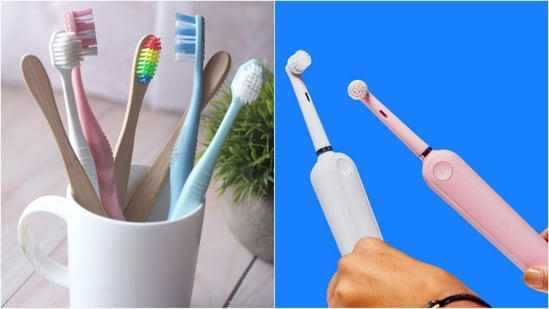Electric vs. Manual Toothbrush: Which One is Better for You? Here’s What the Dentists Recommend
Maintaining oral hygiene is crucial for overall health, and choosing the right toothbrush plays a significant role. The market offers two primary options: electric and manual toothbrushes. Both have their merits, and deciding between them can be perplexing. Let’s delve into the advantages and considerations of each type, along with insights from dental professionals, to help you make an informed decision.
The Advantages of Electric Toothbrushes
Built-in Timers
Many electric toothbrushes come equipped with built-in timers, ensuring that you brush for the recommended two minutes. This feature is particularly beneficial for individuals who tend to rush through their oral care routine.
Ease of Use
Electric toothbrushes are easy to use, making them an excellent choice for children, the elderly, and those with limited mobility. The automated brushing motion simplifies the process and can lead to more consistent brushing habits.
More Effective Plaque Removal
Electric toothbrushes often provide more effective plaque removal compared to manual brushes. The oscillating or rotating brush heads can reach areas that are challenging to access with a manual brush, promoting a thorough clean.
The Benefits of Manual Toothbrushes
Affordable and Accessible
Manual toothbrushes are widely available and are a budget-friendly option. They are convenient for travel and well-suited for those who prefer simplicity in their oral care routine.
Precision Control
Manual toothbrushes allow you to control the brushing pressure and technique. This level of control can be particularly important for individuals with sensitive gums or dental work.
Simple Maintenance
Maintaining a manual toothbrush is straightforward. There are no batteries to worry about, and replacement is as simple as getting a new brush every three to four months.
Factors to Consider When Choosing
Your Oral Health Needs
Consider your specific oral health needs. If you have braces, sensitive gums, or other dental conditions, an electric toothbrush’s specialized features might be beneficial. Otherwise, a manual toothbrush can still provide effective cleaning.
Personal Preferences
Personal preference plays a significant role. Some individuals prefer the manual brushing motion, while others enjoy the convenience of an electric toothbrush. Choose what aligns with your comfort and habits.
Cost Considerations
Electric toothbrushes are typically more expensive upfront, but manual toothbrushes require ongoing replacement. Consider your budget and the long-term costs associated with both options.
The Professional Perspective
Dentists’ Recommendations
Dentists often recommend electric toothbrushes for their ability to provide consistent and thorough cleaning. However, they emphasize that proper technique is more critical than the type of brush.
Insights from Dental Hygienists
Dental hygienists emphasize that the best toothbrush is one that you will use consistently and correctly. Both electric and manual brushes can be effective when used appropriately.
Debunking Common Myths
Myth 1: Electric Brushes Are Aggressive
Electric toothbrushes are not inherently aggressive. Modern models offer various settings, including sensitive modes, to cater to different needs.
Myth 2: Manual Brushes Can’t Clean Thoroughly
Manual brushes can clean thoroughly when used correctly. Technique matters more than the brush type.
Myth 3: One-Size-Fits-All
Every individual has unique oral care needs. One brush type may work better for you, but it might not be the best choice for someone else.
Making the Right Choice for Kids
Instilling Good Oral Habits
For kids, the brushing experience matters. Choose a brush that encourages proper technique and makes brushing enjoyable.
Kid-Friendly Electric Brushes
Electric brushes with fun designs and features can engage children and make brushing more exciting.
Engaging Manual Brushes for Kids
Manual brushes designed with favorite characters or vibrant colors can also motivate children to maintain good oral hygiene.
The Environmental Aspect
Electric Brush Sustainability
Some electric brushes come with replaceable heads, reducing plastic waste. Look for brands that prioritize environmental sustainability.
Biodegradability of Manual Brushes
Manual toothbrushes are typically made from biodegradable materials, making them a greener choice for those concerned about environmental impact.
Overcoming Brushing Challenges
Addressing Sensitivity
If you have sensitive teeth or gums, opt for a toothbrush with soft bristles. Electric brushes with pressure sensors can also help prevent excessive force.
Handling Orthodontic Appliances
Electric brushes with orthodontic brush heads are designed to clean around braces and other appliances effectively.
The Future of Oral Care
Advancements in Electric Brushes
The future holds exciting possibilities for electric brushes, including AI-powered models that provide real-time brushing feedback.
Innovations in Manual Brushes
Manual brushes continue to evolve with ergonomic designs and biodegradable materials, catering to eco-conscious consumers.
In conclusion, the choice between an electric and a manual toothbrush depends on your preferences, oral health needs, and lifestyle. Both types of brushes can effectively contribute to excellent oral hygiene when used correctly. Listen to your dentist’s advice, choose what aligns with your values, and enjoy a healthy smile for years to come.
FAQs
Q. Is an electric toothbrush suitable for sensitive teeth?
A. Yes, many electric toothbrush models have sensitive modes and soft brush heads, making them suitable for individuals with sensitive teeth.
Q. Can I use a manual toothbrush with braces?
A. Yes, a manual toothbrush can effectively clean around braces. However, electric brushes with specialized orthodontic heads might offer added convenience.
Q. Are electric toothbrushes more expensive?
A. Electric toothbrushes tend to have a higher upfront cost, but manual toothbrushes require more frequent replacement, which can add up over time.
Q. How often should I change my toothbrush head?
A. For both electric and manual toothbrushes, it’s recommended to change the brush head or the entire brush every three to four months, or sooner if the bristles are frayed.
Q. Are there eco-friendly electric toothbrush options?
A. Yes, some electric toothbrush brands offer models with replaceable and recyclable brush heads, reducing plastic waste and environmental impact.
